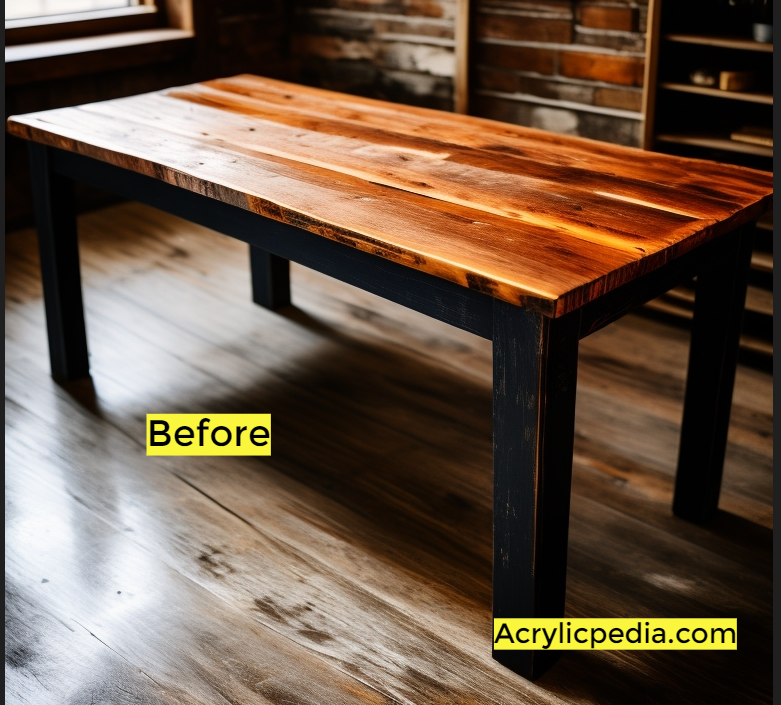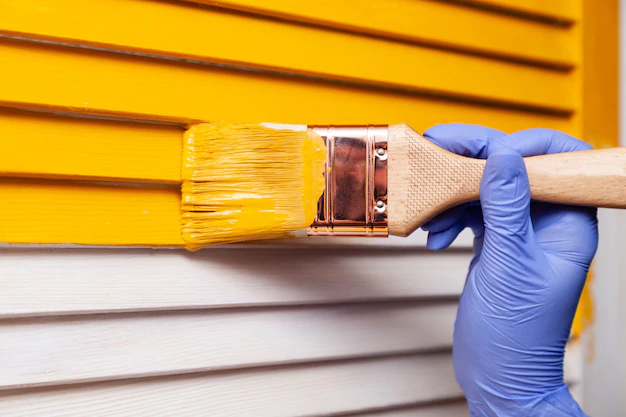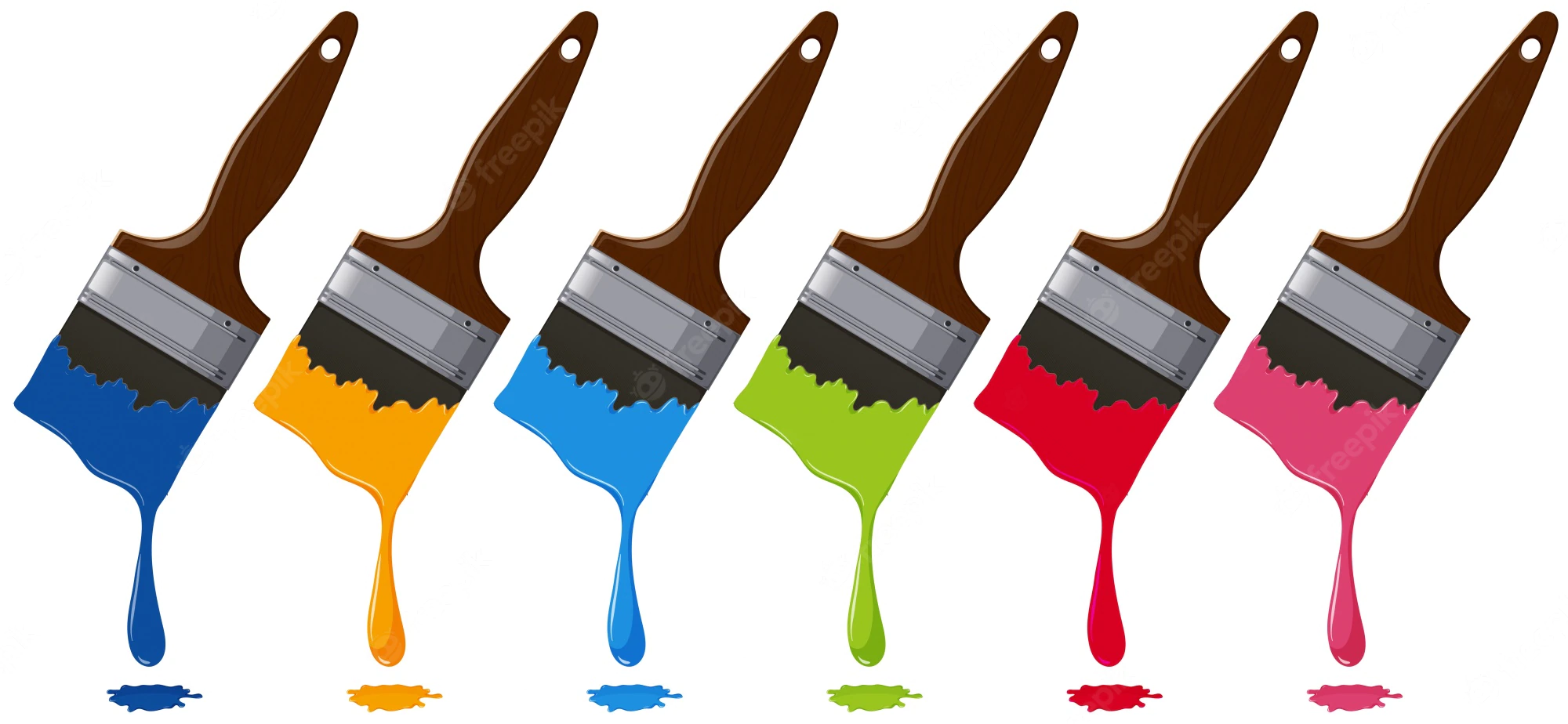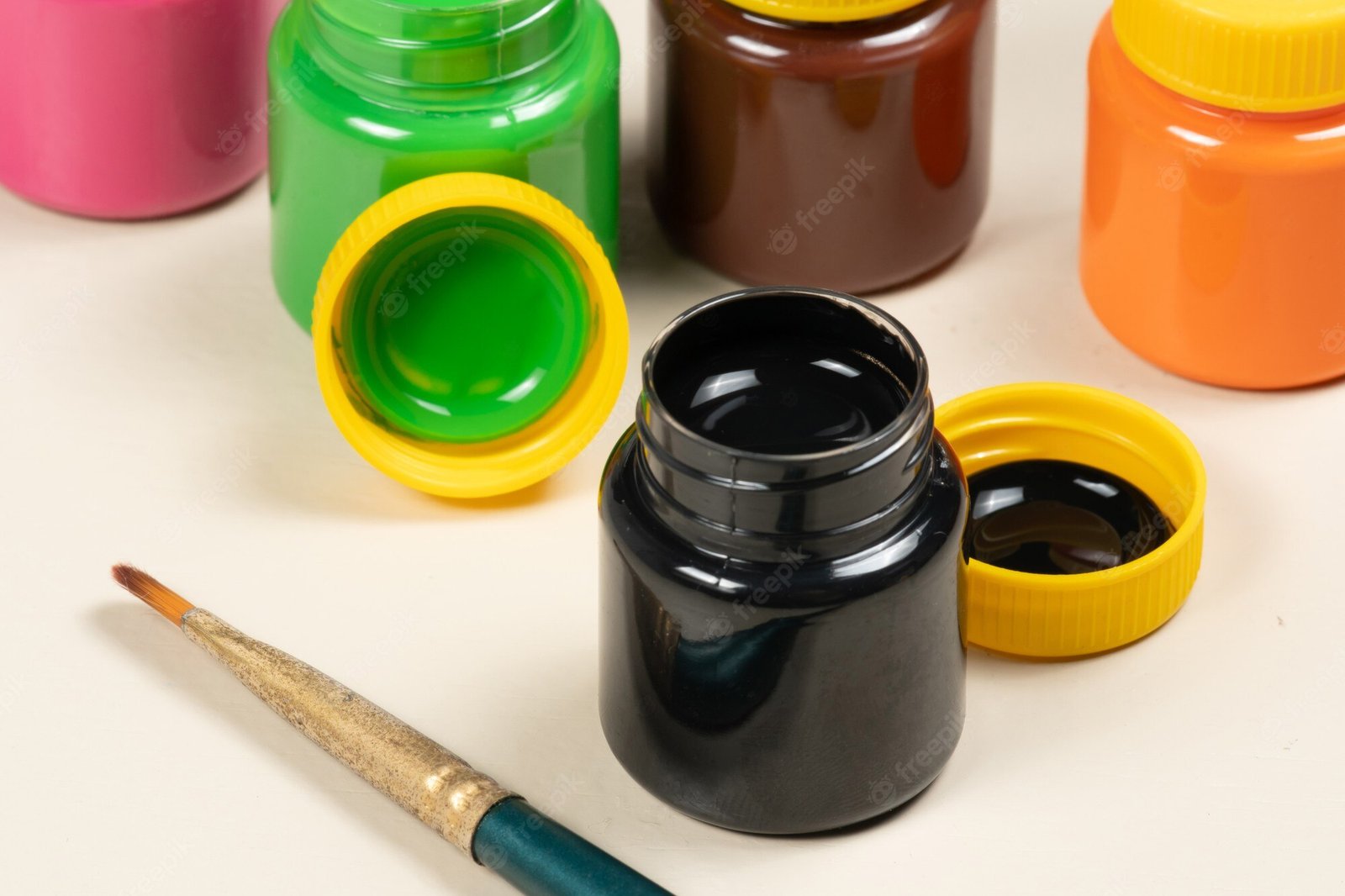When it comes to acrylic paint, there seems to be a lot of confusion about whether one can actually use acrylic paint on wood. Many artists are left wondering whether or not the paint will adhere properly to their piece of wooden furniture or balsa wood.
Acrylic paint can be applied to both primed and unprimed wood surfaces. However, for the best results, always sand and prime your wood surfaces first before applying any acrylic paint. Sanding helps to create a smooth and even surface by removing any imperfections, rough spots or splinters on the wood while priming acts as a bonding agent between the paint and the wood. It provides a stable and consistent surface for the acrylic paint to adhere to. Without proper adhesion, the paint may not stick well to the wood, leading to issues like peeling, flaking, or poor coverage.
If you want to try using acrylic paint on wood , here’s detailed guide on how to make sure your acrylic painting looks great on hard wood, soft wood or composite wood. Whether you are looking to re-paint your old furniture, table , door , this guide will help you.
Recommended Related Posts
- Best Acrylic Paint for Students and Professionals
- Best Neon Paints
- Is Acrylic Paint Toxic to Dogs
- Can You Use Acrylic Paint on Plastic
A Beginner’s Guide To Painting Wood With Acrylic Paint


First Things First, Know the Type of Wood You are Working With
The first thing you need to know before deciding whether or not to use acrylic paint on wood is actually the type of wood you’re working with. There are many types of wood surfaces. You do not want to later find out that the paint you chose isn’t compatible with the wood, resulting in adhesion problems, color inconsistencies. Luckily I have created this table to help you understand all types of wood surfaces that work great with acrylic paint;
Type of Wood | Example |
Softwoods | Pine: Commonly used for painting, it's relatively affordable and has a distinct grain pattern. |
Hardwoods | Oak: Recognizable for its prominent grain, it is also used for furniture and cabinetry. |
Engineered Wood | MDF (Medium-Density Fiberboard): Known for its smooth, uniform surface, it's ideal for detailed artwork. |
Wood Panels | Birch Panels: Pre-primed and excellent for fine art, these panels provide a smooth painting surface. |
Furniture | Tables, chairs, dressers, etc: Wooden furniture can be painted with acrylics for a fresh look or to match your decor. |
Wooden Crafts & Decor | Wooden boxes: Can be used for decorative purposes or storage. |
Outdoor Wood | Decking: Used for exterior-grade acrylic paint to protect and beautify your deck. |
Wooden Signs | Wooden signs: Popular for home decor and customization. |
Others | Balsa wood: Very lightweight and often used in model making. |
How to Paint on Wood With Acrylics? Step-to-Step Process!
Just like applying acrylic paint on metal, plastic, Leather, shoes, skin or fabric, there is a lot of preparation that is required before hand. The process is the same if you are working with acrylic paint on your wood art projects. Here’s what you need to do first;
Step1: Prepare Your Wood by Sanding It Down

The first step to painting on wood is preparing your word. This means sanding down the wood piece so that it’s smooth and does not have any rough spots. It will also make it really easy to paint on. You can use an DEKOPRO Random Orbit Sander 2.5A with 16Pcs Sandpapers, but be sure to wear protective gear and don’t let your hands get too close to the surface of the wood.
If you are low on a budget, I suggest you grab recommend Lotfancy grit sandpaper and work in small sections at a time. I’d like to mention that if you’re using a power sander, make sure that you have plenty of ventilation while you’re sanding down your wood.
Step2: Prime It
You need to prime the surface before painting. Priming wood surfaces is essential because it enhances paint adhesion, preventing chipping or peeling. it also evens out color, allowing your paint to appear as intended. If you’re using a spray-on primer like Rust-Oleum 7797830 Stops Rust Spray Paint , make sure it dries first before attempting to paint on wood. I always prime all my wood surfaces for a professional look . So yes, you should prime it with a good quality water-based primer or gesso. I’ve listed below other primers that I have personally used and loved when I worked on my wood acrylic painting;
Best Acrylic Primer for Wood Projects
1) The Crafters Workshop Gesso Medium, Surface Preparation and Primer


What I loved About this Primer
- Dries Really Fast( at most 30 minutes)
- Can easily be applied with brush or palette knife
2) Liquitex Professional Gesso Surface Prep Medium, 946ml (32-oz), Clear


Step 3. Now, Apply the Acrylic Paint


Wood Canva
Apply the first coat of acrylic paint to your wood surface either with a brush or roller. For best results, roll over the surface with a roller or brush to ensure that you get an even coat of paint. (You can also use a paintbrush.) You have to have some patience here and let the first coat dry completely before applying another coat. Acrylic paint dries really fast.
Side Note: Allow each coat of paint to dry completely before applying another coat of paint (if you’re using an airbrush, wait for a few minutes between each coat). Painting on large wood surfaces may take several hours depending on the size of your project .
Step3: Seal Acrylic Paint on Wood


Acrylic paint is designed to be durable, but it’s not necessarily waterproof. To protect the surface of your wood with acrylic paint, you’ll need to seal it. To sell acrylic paint on wood, follow this guide:
How to Seal Acrylic Paint on Wood?
Materials You’ll Need:
- Acrylic paint on wood( painted project)
- Clear acrylic sealant or varnish
- Paintbrushes or foam brushes
- Sandpaper (fine-grit) -Optional
- Clean cloth or tack cloth
- Plastic sheet or drop cloth (to protect your work area)
Procedure
- Allow the Acrylic Paint to Dry: Make sure the acrylic paint on the wood is completely dry. It’s essential to give it ample time to set, typically at least 30 minutes. I have an entire article on how long it takes acrylic paint to dry, check it out.
- Select Your Sealant: Choose a clear acrylic sealant or varnish you like. You can opt for water-based or solvent-based, depending on your preference and the intended use of the sealed surface. Water-based options tend to have lower odors and are more environmentally friendly.
- Start Applying the Sealant: Apply the sealant using either a clean brush or foam brush. Work in smooth, even strokes, following the wood’s grain if applicable. Avoid overworking the sealant, as it can lead to streaks or bubbles. You should not ruin your work and effort.
- Allow Drying: Let the first coat of sealant dry completely typically about 2-4 hours before adding additional coats.
- Apply Additional Coats: Next, apply additional coats as needed for durability and the desired level of protection. Usually, 2-3 coats are sufficient, but you can add more if necessary. Allow each coat to dry between applications.
- Sand Between Coats (Optional): If you desire an exceptionally smooth finish, you can lightly sand the surface with fine-grit sandpaper between coats of sealant to remove imperfections. Remember to clean away any dust before applying the next coat.
- Allow for Full Curing: The sealant may be dry to the touch relatively quickly, but it takes time to fully cure ( at least 24 -48 hours). In some cases, it may take even several days for your work to fully cure if you are living in cold areas. I recommend blow dryer to fasten curing.
Best Sealants for Acrylic Paint on Wood
1) Use a Spray
The easiest way to seal your acrylic paint job on wood is to use a spray varnish or lacquer. This will give your project an even, glossy finish and seal it from moisture damage. However, these products can be expensive and may need to be reapplied every few months. I recommend Mod podge as it is one of the best sealants on the market and Rust-Oleum 249117 Painter’s Touch 2X Ultra Cover Spray Paint, 12 oz, Gloss Clear.
2) Use Furniture Wax
If you want a more natural look for your project or if you don’t want it to have high gloss, you can use furniture wax instead of spray varnish or lacquer. I personally love Daddy Van’s All Natural Unscented Beeswax Furniture Polish Wood Wax for its non-toxic and odorless nature. Furniture wax will provide some protection against moisture damage. It’s also easier to apply than spray varnishes because it doesn’t require any special equipment or expertise in application techniques.
3) Polyacrylic Sealant
Polyacrylic sealants are a type of acrylic paint sealants, which is different from polyurethane in that it does not require the use of solvents and catalysts. It is often used as a top coat for polyurethane and acrylic paints because it will not yellow or crack like polyurethane. Polyacrylic sealant works by providing a protective barrier between your wood and the elements. This means that you will be able to use your wood without worrying about weather or other environmental factors damaging it. It also helps to prevent stains from penetrating into the wood so that your newly painted surface stays looking nice and new for longer. I Recommended Polyacrylic Sealant: Minwax 222224444 Polycrylic Protective Finish Water Based.
4)Varnish
Another most traditional way to seal acrylic paint on wood is by using varnish. You can use any type of varnish for this purpose, as long as it’s compatible with acrylics and doesn’t contain any solvents that could dissolve the paint underneath it (which would cause peeling). The Liquitex BASICS Matte Varnish does this job very well, so be sure to check it out on Amazon.
5) Epoxy Resin
Epoxy Resin is a clear liquid that hardens when exposed to air or heat; this creates a protective layer over your surface which repels dirt and liquids so that your piece does not get damaged easily. You can apply Epoxy resin just after you have sealed your wood painting. I recommend the Beast Bond Epoxy Resin, With only 40 minutes of drying time, this product will give your painting a gloss finish. It is also free of fumes and non-inflammable. Which is a plus.
6)Polyacrylic Sealant Vs Polyurethane Sealant for Acrylic paint on Wood
Both polyacrylic and polyurethane sealants are commonly used to protect acrylic paint on wood surfaces, but they have some differences in terms of characteristics and applications:
Polyacrylic Sealant
- Water-Based: Polyacrylic sealant is water-based, making it a more environmentally friendly and less toxic option compared to oil-based polyurethane.
- Clarity: Polyacrylic typically dries clear and remains clear over time. This makes it a good choice when you want to preserve the natural appearance of the wood or protect acrylic paints without altering their color or sheen.
- Low Odor: It generally has a lower odor than oil-based polyurethane, which can be an advantage when working on indoor projects.
- Quick Drying: Polyacrylic sealant often dries relatively quickly between coats, allowing for faster project completion.
- Ease of Clean-up: Since it’s water-based, cleaning brushes and tools is simple and can be done with water, eliminating the need for harsh solvents.
- Sheen Options: Polyacrylic sealant is available in various finishes, such as matte, satin, semi-gloss, and high-gloss, allowing you to choose the level of sheen that suits your project.
Examples of Polyacrylic or Water-Based Polyurethane Sealants
- Minwax Polycrylic Protective Finish: Minwax offers a range of water-based polyacrylic protective finishes in different sheens (matte, satin, semi-gloss, and gloss). These are widely used for protecting wood surfaces, including those with acrylic paint.
- Varathane Crystal Clear Water-Based Polyurethane: Varathane produces a crystal-clear water-based polyurethane that is ideal for protecting wood projects and painted surfaces, including those with acrylics.
- General Finishes High-Performance Water-Based Topcoat: General Finishes offers a high-performance water-based topcoat that is often used to protect painted and stained wood surfaces. It is available in various sheens, from flat to gloss.
- Rust-Oleum Varathane Ultimate Polyurethane: Rust-Oleum’s Varathane Ultimate Polyurethane is a water-based polyurethane finish that provides excellent protection for wood projects and painted surfaces.
- Minwax Fast Drying Polyurethane Spray: This oil based spray is designed to protect exterior wood surfaces and can be used on painted or stained wood.
Polyurethane Sealant
- Durability: Polyurethane sealant is oil -based It tends to be more durable and resistant to wear and moisture compared to polyacrylic. It is often used for high-traffic areas or items exposed to the elements.
- Ambering: Oil-based polyurethane can amber or yellow over time, which may alter the appearance of the wood or acrylic paint to some extent. Water-based polyurethane has less ambering.
- Application: Polyurethane can be a bit trickier to apply because it may require more coats, and it’s critical to avoid streaks and bubbles. It often takes longer to dry between coats.
When choosing between polyacrylic and polyurethane sealants for protecting acrylic paint on wood, consider your project’s specific needs. If you want to maintain the clarity and color of the paint while working indoors and value ease of use and low odor, polyacrylic is a suitable choice. On the other hand, if durability and resistance to wear and moisture are critical, especially for outdoor or high-traffic areas, polyurethane might be the better option.
Is It Necessary to Apply a Sealant to Acrylic Paint on Wood?
Applying a sealant to acrylic paint on wood is not always necessary but is highly recommended. A sealant provides several key benefits. It protects the paint from wear and tear, UV rays, and moisture, which can lead to fading, cracking, or peeling. It also creates a barrier against dirt and stains, making the surface easier to clean. . While sealing isn’t compulsory, it significantly prolongs the life and quality of your acrylic-painted wood projects, making it a wise choice for long-term durability and aesthetic preservation.
Best Acrylic Paint for Wood
If you are looking for the best acrylic paint for your next wood project, you should know that your options are many. To help you narrow down your options , I did a full review on the Top 10 best acrylic paints. According to ratings, here the top 4 you should definitely use on your wood art project;
1) Nicpro 18 Colors Large Acrylic Paint Set


- Gives a matte finish
- Non-Toxic
- Recommended for wood
2) Craft Paint Acrylic Premium Acrylic Paint Set 20 Colors Paint Acrylic


- Gives a matte finish
- Comes in a set of 20 acrylic paint colors
- Non-Toxic
- Perfect for wood projects
3) Liquitex BASICS Acrylic Paint Set, 60 x 22ml (0.74-oz) Tube Paint Set


- Gives a Gloss Finish
- Also Non-Toxic
- Student-Quality Acrylic Paint
4)Liquitex Professional Heavy Body Acrylic Paint, Classic 12 x 59ml (2-oz) Set


- Gives a Satin Finish
- Easy to Clean Up
- Comes with 2x titanium White
Do You Need to Prime Wood Before Painting With Acrylics?


Acrylic paints are water based and can be applied directly over most surfaces without the need for primer. However, priming will give your paint a more solid surface to adhere to and prevent it from peeling off over time due to normal wear and tear (like when you move furniture around).
Besides, it will also provide an even surface that helps eliminate brush marks that can result in uneven coloring once the paint has dried. This is especially important when using more than one color in a project because it helps prevent the colors from mixing too much together or bleeding into each other during application.
How Do You Prep Wood for Acrylic Paint?
To prep wood for acrylic paint, you need to sand it with a fine grade of sandpaper. Start with 80-grit sandpaper and work your way up to 220-grit. You can also use a power sander if you prefer not to hand sand. Apply painter’s tape to the edges of your piece or any areas you don’t want painted. Then, wipe down the entire surface with a tack cloth. This will remove any dust or debris that might cause your paint to crack or peel over time.
What About Wood Furniture, Wood crafts and wood Doors ?
Can You Use Acrylic Paint on Wood Furniture?
You can use acrylic paints on all your wood furniture projects. Just make sure that you use a primer paint first if the surface of your piece is porous (meaning it has tiny holes in it). Primer will seal those holes, preventing the paint from soaking into them and causing peeling later on down the road.
Can You Use Acrylic Paint on Wood Crafts?
Acrylic paints are perfect crafts . If you’re planning on using acrylic paint on wood crafts, there are some important considerations you’ll need to keep in mind when choosing your materials and techniques. You’ll want to use an artist quality acrylic paint. Again, you’ll also want to choose paints that are compatible with each other so they don’t “bleed” into each other when mixed together on the same surface or layered over one another during application. Another key point is using a primer and later seal your work to protect it from dust or yellowing.
How About Acrylic Paint on Wood Doors, Is It a Good Idea?
You can paint acrylic paint on wood doors. Painting wood doors with acrylic paint is a good idea if done correctly. It is a versatile option for wood doors, as it dries quickly, resists cracking, and provides a range of color choices. However, proper surface preparation is a must. Sand the door to create a smooth, clean surface, and apply a wood primer to ensure good paint adhesion. Keep in mind that you might require multiple coats of acrylic paint for even coverage, which is fine. Just don’t forget to finish with a clear acrylic sealant to protect the paint and wood.


Can You Use Acrylic Paint on Balsa Wood?
Absolutely, you can use acrylic paint on balsa wood. Balsa’s lightweight nature and its porous surface accepts acrylic paint well, and the paint dries quickly. I’ve personally worked with it, and it was fun and easy. I found it fun to experiment with different colors and techniques, knowing that the paint adhered smoothly. Just a bit of sanding and a primer coat helps to achieve a fantastic, professional finish. You should try it- it is a delightful and user-friendly creative experience.
Acrylic Paint on Exterior Wood, Is it Recommended?
Exterior wood refers to wood surfaces exposed to outdoor elements and weather conditions. This includes wood used for outdoor structures like decks, fences, siding, and outdoor furniture, as well as exterior trim and doors on houses. Due to its exposure to moisture, UV rays, temperature fluctuations, and other environmental factors, exterior wood requires specific protection and maintenance.
can you use acrylic paint on exterior wood? You can use acrylic paint on exterior wood, but it’s essential to do thorough surface preparation ( sanding and priming)and applying a clear sealer or exterior varnish to protect the paint and wood from the elements. Proper maintenance and repainting are also necessary to maintain the wood’s appearance and protection over time. Acrylic paint provides a durable and versatile option for exterior wood surfaces when applied and maintained correctly.


My Experience Using Acrylic Paint on My Wood Old Table
My dad had this old wooden table that sort of looked like it was bought during world war 2. Instead of letting it rot away, I decided to paint it with Nicpro 24 Colors Large Bulk Acrylic Paint Set (16.9 oz,500 ml). The table was old as hell, but I was determined to make it beautiful again. I started with sanding, and I used fine-grit paper to create a smooth canvas. Surprisingly, the process was quite easy, and the wood surface responded well. Next, I applied a layer of Liquitex Professional Gesso Surface Prep Medium to prime the table. It took just a few minutes for the primer to dry.
I took the wooden table out side and started painting it. I added more cool colors and also applied my own personal touch to it. It took me the whole day( Sunday ) to finish painting it. I can’t complain at all because it was quiet fun and I enjoyed listening to Kendrick Lamar as I painted away. It came out smooth and really great. My dad loved it.
To seal my work, I chose Rust-Oleum 249117 Painter’s Touch 2X Ultra Cover Spray Paint in Gloss Clear , which is Aerosol. This sealer added a glossy finish that enhanced the colors and gave the table a sleek, polished appearance. By the way I wanted to sell it on eBay but my dad said no. I guess he is attached to the table. See before and after pics below;




Frequently Asked Questions
What type of paint should I use for painting on wood?
The best type of paint for painting on wood is ) Liquitex BASICS Acrylic Paint Set, This type of paint has been used for many years and has proven to be one of the best choices when it comes to durability and longevity of your art work or project.
What is the best way to clean acrylic paint off of my hands?
Wash your hands with soap and water. If you want to speed up the drying time, add a little bit of vinegar to the water.
Can you use any type of wood for your project?
You can use almost any type of wood for your project. However, if you want a smooth finish or if there is a lot of detail involved in your project, then I would recommend using plywood or another type of hardwood such as walnut, mahogany or birch.
Should I Prime First, Before Applying Acrylic Paint?
It is highly recommended to prime your wood surface or object before painting acrylic paint on it for better paint adhesion. You can use either use varnish , spray primer or gesso.
Conclusion
Acrylic paints are versatile and offer artists a great deal of freedom when it comes to method of application. They can be used on a wide variety of surfaces including canvas, wood, ceramic, stone, and more. It depends entirely on the specific brand of paint that you choose to use . Overall, acrylic paint works just fine on wood, Enjoy your painting. You can also share your painting experience in the comment section below.
SOURCES
6 Tips to Follow When Painting with Acrylics on Wood Furniture
https://www.angi.com/articles/tips-to-using-acrylic-paint-on-wood.htm
How To Protect Acrylic Paint on Wood
https://www.wikihow.com/Protect-Acrylic-Paint-on-Wood
Can I varnish acrylic paintings with wood varnish?
https://www.quora.com/Can-I-varnish-acrylic-paintings-with-wood-varnish
The Best Paint For Wood Crafts
https://www.homedit.com/paint-for-wood-crafts/
Painting Over Stained Wood: A How-To Guide
https://www.mymove.com/home-inspiration/painting/paint-over-wood-stain/
11 Different Types of Wood and Their Uses
https://www.maramani.com/blogs/home-design-ideas/different-types-wood






